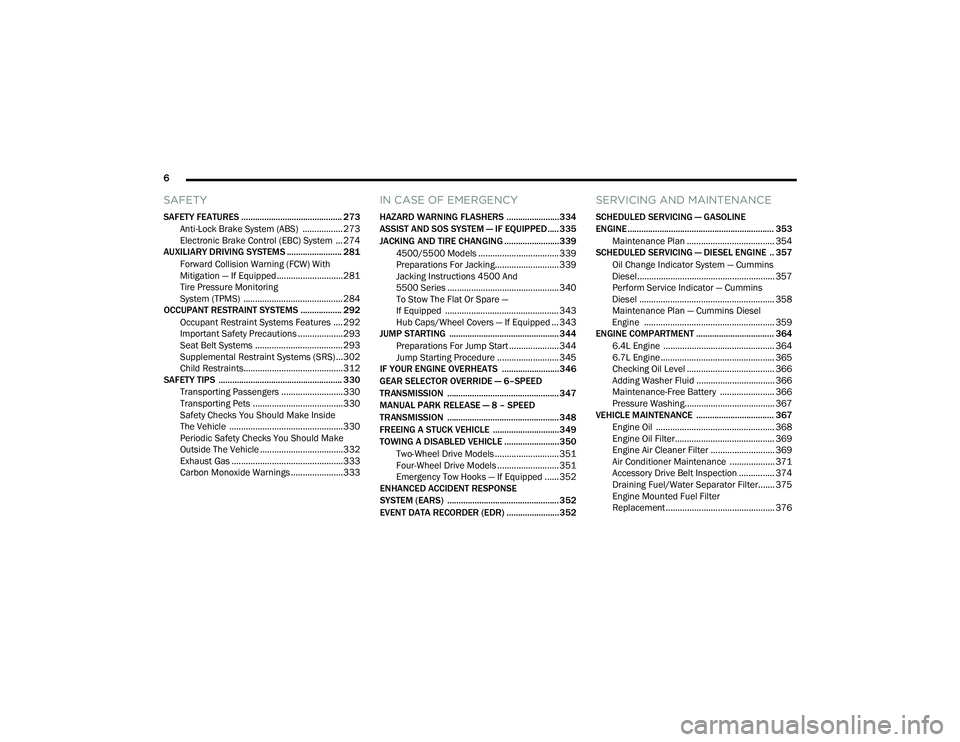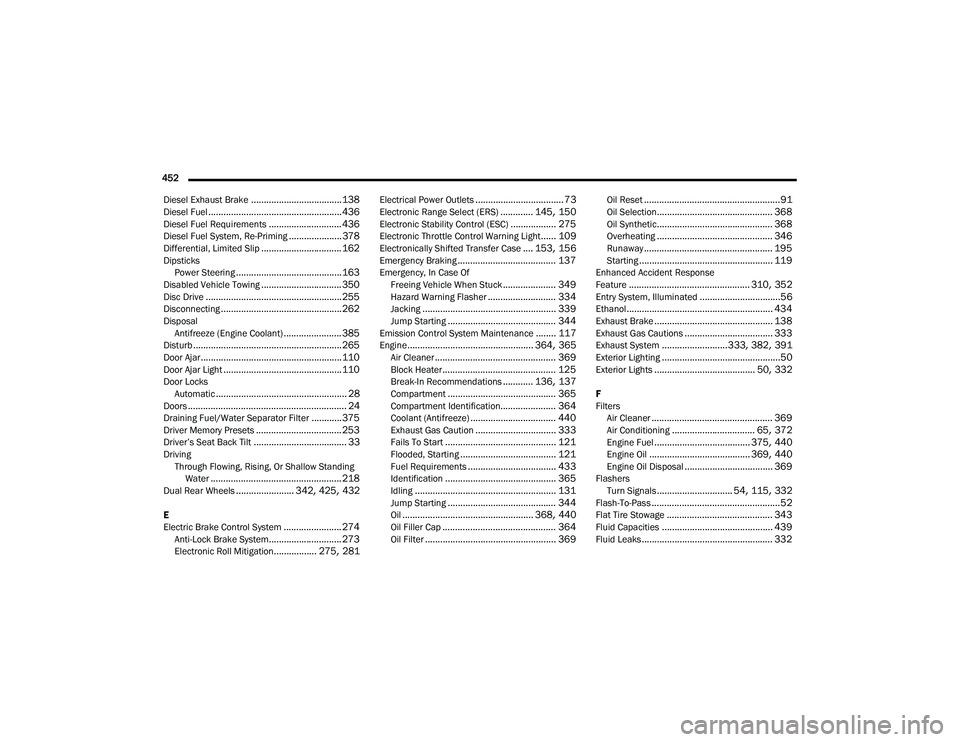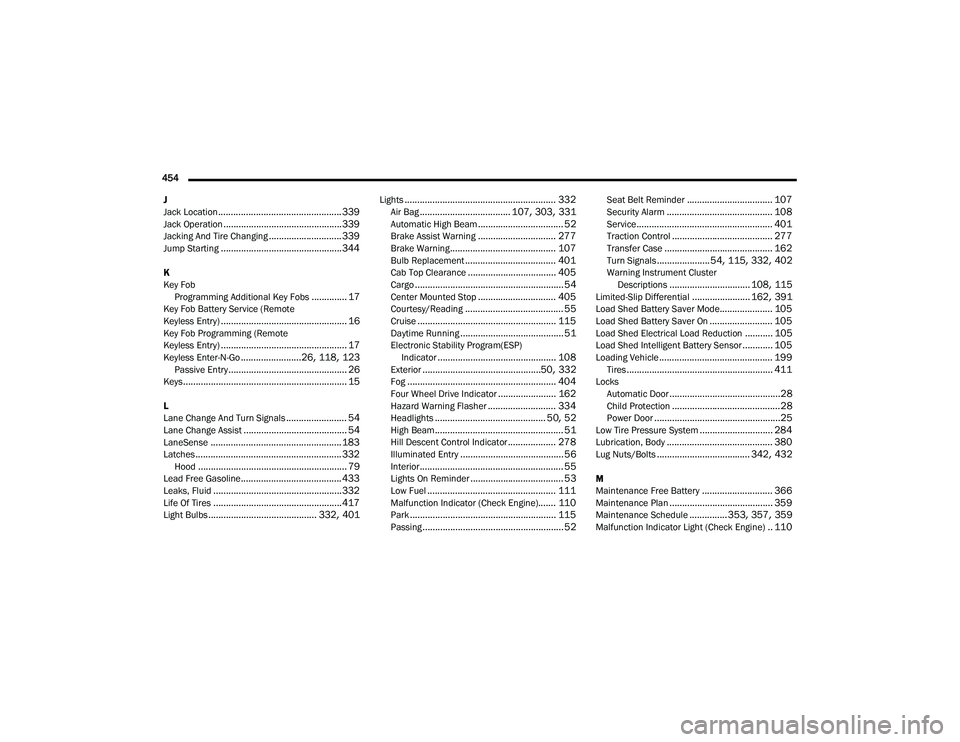jump start RAM CHASSIS CAB 2021 Owners Manual
[x] Cancel search | Manufacturer: RAM, Model Year: 2021, Model line: CHASSIS CAB, Model: RAM CHASSIS CAB 2021Pages: 463, PDF Size: 21.5 MB
Page 8 of 463

6
SAFETY
SAFETY FEATURES ............................................ 273
Anti-Lock Brake System (ABS) ................. 273
Electronic Brake Control (EBC) System ...274
AUXILIARY DRIVING SYSTEMS ........................ 281
Forward Collision Warning (FCW) With
Mitigation — If Equipped............................281 Tire Pressure Monitoring
System (TPMS) ..........................................284
OCCUPANT RESTRAINT SYSTEMS .................. 292
Occupant Restraint Systems Features ....292
Important Safety Precautions ...................293Seat Belt Systems ..................................... 293Supplemental Restraint Systems (SRS) ...302Child Restraints..........................................312
SAFETY TIPS ...................................................... 330
Transporting Passengers ..........................330
Transporting Pets ......................................330
Safety Checks You Should Make Inside
The Vehicle ................................................330 Periodic Safety Checks You Should Make
Outside The Vehicle ...................................332 Exhaust Gas ...............................................333Carbon Monoxide Warnings ......................333
IN CASE OF EMERGENCY
HAZARD WARNING FLASHERS .......................334
ASSIST AND SOS SYSTEM — IF EQUIPPED..... 335
JACKING AND TIRE CHANGING ........................339
4500/5500 Models .................................. 339Preparations For Jacking........................... 339
Jacking Instructions 4500 And
5500 Series ............................................... 340 To Stow The Flat Or Spare —
If Equipped ................................................ 343 Hub Caps/Wheel Covers — If Equipped ... 343
JUMP STARTING ................................................ 344
Preparations For Jump Start ..................... 344Jump Starting Procedure .......................... 345
IF YOUR ENGINE OVERHEATS .........................346
GEAR SELECTOR OVERRIDE — 6–SPEED
TRANSMISSION ................................................. 347
MANUAL PARK RELEASE — 8 – SPEED
TRANSMISSION ................................................. 348
FREEING A STUCK VEHICLE .............................349
TOWING A DISABLED VEHICLE ........................350 Two-Wheel Drive Models ........................... 351
Four-Wheel Drive Models .......................... 351Emergency Tow Hooks — If Equipped ...... 352
ENHANCED ACCIDENT RESPONSE
SYSTEM (EARS) ................................................. 352
EVENT DATA RECORDER (EDR) .......................352
SERVICING AND MAINTENANCE
SCHEDULED SERVICING — GASOLINE
ENGINE ................................................................ 353
Maintenance Plan ..................................... 354
SCHEDULED SERVICING — DIESEL ENGINE .. 357
Oil Change Indicator System — Cummins
Diesel.......................................................... 357 Perform Service Indicator — Cummins
Diesel ......................................................... 358 Maintenance Plan — Cummins Diesel
Engine ....................................................... 359
ENGINE COMPARTMENT .................................. 364
6.4L Engine ............................................... 364
6.7L Engine ................................................ 365
Checking Oil Level ..................................... 366
Adding Washer Fluid ................................. 366Maintenance-Free Battery ....................... 366Pressure Washing...................................... 367
VEHICLE MAINTENANCE .................................. 367
Engine Oil .................................................. 368
Engine Oil Filter.......................................... 369
Engine Air Cleaner Filter ........................... 369
Air Conditioner Maintenance ................... 371
Accessory Drive Belt Inspection ............... 374Draining Fuel/Water Separator Filter....... 375Engine Mounted Fuel Filter
Replacement.............................................. 376
21_DPF_OM_EN_USC_t.book Page 6
Page 346 of 463

344IN CASE OF EMERGENCY
Replace the wheel covers using a rubber mallet
to ease the installation. Align the wheel cover
vent holes to the wheel vent holes. Tap on the
wheel cover as needed to firmly seat it evenly
around the wheel.
JUMP STARTING
If your vehicle has a discharged battery, it can
be jump started using a set of jumper cables
and a battery in another vehicle, or by using a
portable battery booster pack. Jump starting
can be dangerous if done improperly, so please
follow the procedures in this section carefully. NOTE:
When using a portable battery booster pack,
follow the manufacturer's operating instruc
-
tions and precautions.
PREPARATIONS FOR JUMP START
The battery in your vehicle is located in the front
of the engine compartment, behind the left
headlight assembly.
Battery Location
If you have a diesel engine, you may have two
batteries, however jump start off the driver side
battery.
The positive battery post may be covered with a
protective cap if equipped. Lift up on the cap to
gain access to the positive battery post. Do not
jump off fuses. Only jump directly off positive
post which has a positive
(+) symbol on or
around the post.
Positive (+) Battery Post
NOTE:
1. Apply the parking brake, shift the automatic transmission into PARK and
turn the ignition OFF.
2. Turn off the heater, radio, and all electrical accessories.
The rear hub caps on the dual rear wheel
has two pull off notches. Make sure that the
hook of the jack handle driver is located
squarely in the cap notch before attempting
to pull off.
WARNING!
Do not attempt jump starting if the battery is
frozen. It could rupture or explode and cause
personal injury.
CAUTION! (Continued)CAUTION!
Do not use a portable battery booster pack or
any other booster source with a system
voltage greater than 12 Volts or damage to
the battery, starter motor, alternator or
electrical system may occur.
21_DPF_OM_EN_USC_t.book Page 344
Page 347 of 463

IN CASE OF EMERGENCY345
3. If using another vehicle to jump start the
battery, park the vehicle within the jumper
cables reach, apply the parking brake, and
make sure the ignition is OFF.JUMP STARTING PROCEDURE
NOTE:
Make sure at all times that unused ends of
jumper cables are not contacting each other or
either vehicle while making connections.
Connecting The Jumper Cables
1. Connect the positive
(+) end of the jumper
cable to the positive (+)
post of the
discharged vehicle.
NOTE:
Do not jump off fuses. Only jump directly off
positive post. 2. Connect the opposite end of the positive
(+)
jumper cable to the positive (+) post of the
booster battery.
3. Connect the negative (-) end of the jumper
cable to the negative (-) post of the booster
battery.
4. Connect the opposite end of the negative (-)
jumper cable to a good engine ground.
A “ground” is an exposed metallic/
unpainted part of the engine, frame or
chassis, such as an accessory bracket or
large bolt. The ground must be away from
the battery and fuel injection system.
5. Start the engine in the vehicle that has the booster battery, let the engine idle a few
minutes, and then start the engine in the
vehicle with the discharged battery.
WARNING!
Take care to avoid the radiator cooling fan
whenever the hood is raised. It can start
anytime the ignition switch is ON. You can
be injured by moving fan blades.
Remove any metal jewelry such as rings,
watch bands and bracelets that could
make an inadvertent electrical contact.
You could be seriously injured.
Batteries contain sulfuric acid that can
burn your skin or eyes and generate
hydrogen gas which is flammable and
explosive. Keep open flames or sparks
away from the battery.
WARNING!
Do not allow vehicles to touch each other as
this could establish a ground connection and
personal injury could result.
WARNING!
Failure to follow this jump starting procedure
could result in personal injury or property
damage due to battery explosion.
CAUTION!
Failure to follow these procedures could
result in damage to the charging system of
the booster vehicle or the discharged vehicle.
WARNING!
Do not connect the jumper cable to the
negative (-) post of the discharged battery.
The resulting electrical spark could cause the
battery to explode and could result in
personal injury.7
21_DPF_OM_EN_USC_t.book Page 345
Page 348 of 463

346IN CASE OF EMERGENCY
6. Once the engine is started, follow the
disconnecting procedure below.
Disconnecting The Jumper Cables
1. Disconnect the negative
(-)
end of the
jumper cable from the engine ground of
the vehicle with the discharged battery.
2. Disconnect the opposite end of the negative (-) jumper cable from the
negative (-) post of the booster battery.
3. Disconnect the positive (+) end of the
jumper cable from the positive (+) post of
the booster battery.
4. Disconnect the opposite end of the positive (+) jumper cable from the
positive (+) post of the vehicle with the
discharged battery.
If frequent jump starting is required to start your
vehicle you should have the battery and charging
system inspected at an authorized dealer.
IF YOUR ENGINE OVERHEATS
In any of the following situations, you can
reduce the potential for overheating by taking
the appropriate action.
On the highways — slow down.
In city traffic — while stopped, place the trans
-
mission in NEUTRAL, but do not increase the
engine idle speed while preventing vehicle
motion with the brakes. NOTE:
There are steps that you can take to slow down
an impending overheat condition:
If your Air Conditioner (A/C) is on, turn it off.
The A/C system adds heat to the engine
cooling system and turning the A/C off can
help remove this heat.
You can also turn the temperature control to
maximum heat, the mode control to floor and
the blower control to high. This allows the
heater core to act as a supplement to the
radiator and aids in removing heat from the
engine cooling system.
CAUTION!
Do not connect jumper cable to any of the
fuses on the positive battery terminal. The
resulting electrical current will blow the fuse.
CAUTION!
Accessories plugged into the vehicle power
outlets draw power from the vehicle’s battery,
even when not in use (i.e., cellular devices,
etc.). Eventually, if plugged in long enough
without engine operation, the vehicle’s battery
will discharge sufficiently to degrade battery
life and/or prevent the engine from starting.
WARNING!
You or others can be badly burned by hot
engine coolant (antifreeze) or steam from
your radiator. If you see or hear steam coming
from under the hood, do not open the hood
until the radiator has had time to cool. Never
try to open a cooling system pressure cap
when the radiator or coolant bottle is hot.
21_DPF_OM_EN_USC_t.book Page 346
Page 376 of 463

374SERVICING AND MAINTENANCE
8. Pull the tension tether outward and reinstall the
glove compartment past the travel stops by
pushing in on the glove compartment sides.
Glove Compartment
NOTE:
Ensure the glove compartment door hinges and
glove compartment travel stops are fully
engaged.
9. Reattach the glove compartment tension tether by inserting the tether clip in the
glove compartment and sliding the clip
away from the face of the glove
compartment door.ACCESSORY DRIVE BELT INSPECTION
When inspecting accessory drive belts, small
cracks that run across ribbed surface of belt
from rib to rib, are considered normal. These
are not a reason to replace belt. However,
cracks running along a rib (not across) are not
normal. Any belt with cracks running along a rib
must be replaced. Also have the belt replaced if
it has excessive wear, frayed cords or severe
glazing.
Accessory Belt (Serpentine Belt)
Conditions that would require replacement:
Rib chunking (one or more ribs has sepa -
rated from belt body)
Rib or belt wear
Longitudinal belt cracking (cracks between
two ribs)
Belt slips
“Groove jumping" (belt does not maintain
correct position on pulley)
Belt broken (note: identify and correct
problem before new belt is installed)
Noise (objectionable squeal, squeak, or
rumble is heard or felt while drive belt is in
operation)
1 — Glove Compartment Travel Stop
2 — Glove Compartment Tension Tether
3 — Glove Compartment Door
WARNING!
Do not attempt to inspect an accessory
drive belt with vehicle running.
When working near the radiator cooling fan,
disconnect the fan motor lead. The fan is
temperature controlled and can start at any
time regardless of ignition mode. You could
be injured by the moving fan blades.
You can be badly injured working on or
around a motor vehicle. Only do service work
for which you have the knowledge and the
proper equipment. If you have any doubt
about your ability to perform a service job,
take your vehicle to a competent mechanic.
21_DPF_OM_EN_USC_t.book Page 374
Page 454 of 463

452 Diesel Exhaust Brake
.................................... 138Diesel Fuel..................................................... 436Diesel Fuel Requirements............................. 436Diesel Fuel System, Re-Priming..................... 378Differential, Limited Slip................................ 162Dipsticks Power Steering.......................................... 163Disabled Vehicle Towing................................ 350Disc Drive...................................................... 255Disconnecting................................................ 262DisposalAntifreeze (Engine Coolant)....................... 385Disturb........................................................... 265Door Ajar........................................................ 110Door Ajar Light............................................... 110Door LocksAutomatic.................................................... 28Doors............................................................... 24Draining Fuel/Water Separator Filter............ 375Driver Memory Presets.................................. 253Driver’s Seat Back Tilt..................................... 33DrivingThrough Flowing, Rising, Or Shallow Standing Water
.................................................... 218Dual Rear Wheels....................... 342, 425, 432
E
Electric Brake Control System....................... 274Anti-Lock Brake System............................. 273Electronic Roll Mitigation................. 275, 281
Electrical Power Outlets................................... 73Electronic Range Select (ERS)............. 145, 150Electronic Stability Control (ESC).................. 275Electronic Throttle Control Warning Light...... 109Electronically Shifted Transfer Case.... 153, 156Emergency Braking....................................... 137Emergency, In Case OfFreeing Vehicle When Stuck..................... 349Hazard Warning Flasher........................... 334Jacking..................................................... 339Jump Starting........................................... 344Emission Control System Maintenance........ 117Engine.................................................. 364, 365Air Cleaner................................................ 369Block Heater............................................. 125Break-In Recommendations............ 136, 137Compartment........................................... 365Compartment Identification...................... 364Coolant (Antifreeze).................................. 440Exhaust Gas Caution................................ 333Fails To Start............................................ 121Flooded, Starting...................................... 121Fuel Requirements................................... 433Identification............................................ 365Idling........................................................ 131Jump Starting........................................... 344Oil.................................................... 368, 440Oil Filler Cap............................................. 364Oil Filter.................................................... 369
Oil Reset......................................................91Oil Selection.............................................. 368Oil Synthetic.............................................. 368Overheating.............................................. 346Runaway................................................... 195Starting..................................................... 119Enhanced Accident Response
Feature................................................ 310, 352Entry System, Illuminated................................56Ethanol.......................................................... 434Exhaust Brake............................................... 138Exhaust Gas Cautions................................... 333Exhaust System..........................333, 382, 391Exterior Lighting...............................................50Exterior Lights........................................ 50, 332
F
FiltersAir Cleaner
................................................ 369Air Conditioning................................. 65, 372Engine Fuel...................................... 375, 440Engine Oil........................................ 369, 440Engine Oil Disposal................................... 369FlashersTurn Signals.............................. 54, 115, 332Flash-To-Pass...................................................52Flat Tire Stowage.......................................... 343Fluid Capacities............................................ 439Fluid Leaks.................................................... 332
21_DPF_OM_EN_USC_t.book Page 452
Page 456 of 463

454 J
Jack Location
................................................. 339Jack Operation............................................... 339Jacking And Tire Changing............................. 339Jump Starting................................................ 344
K
Key Fob Programming Additional Key Fobs
.............. 17Key Fob Battery Service (Remote
Keyless Entry).................................................. 16Key Fob Programming (Remote
Keyless Entry).................................................. 17Keyless Enter-N-Go........................26, 118, 123Passive Entry............................................... 26Keys................................................................. 15
L
Lane Change And Turn Signals........................ 54Lane Change Assist......................................... 54LaneSense.................................................... 183Latches.......................................................... 332Hood........................................................... 79Lead Free Gasoline........................................ 433Leaks, Fluid................................................... 332Life Of Tires................................................... 417Light Bulbs........................................... 332, 401
Lights............................................................ 332Air Bag.................................... 107, 303, 331Automatic High Beam.................................. 52Brake Assist Warning............................... 277Brake Warning.......................................... 107Bulb Replacement.................................... 401Cab Top Clearance................................... 405Cargo........................................................... 54Center Mounted Stop............................... 405Courtesy/Reading....................................... 55Cruise....................................................... 115Daytime Running......................................... 51Electronic Stability Program(ESP) Indicator............................................... 108Exterior...............................................50, 332Fog........................................................... 404Four Wheel Drive Indicator....................... 162Hazard Warning Flasher........................... 334Headlights............................................ 50, 52High Beam................................................... 51Hill Descent Control Indicator................... 278Illuminated Entry......................................... 56Interior......................................................... 55Lights On Reminder..................................... 53Low Fuel................................................... 111Malfunction Indicator (Check Engine)....... 110Park.......................................................... 115Passing........................................................ 52
Seat Belt Reminder.................................. 107Security Alarm.......................................... 108Service...................................................... 401Traction Control........................................ 277Transfer Case........................................... 162Turn Signals..................... 54, 115, 332, 402Warning Instrument Cluster Descriptions................................ 108, 115Limited-Slip Differential....................... 162, 391Load Shed Battery Saver Mode..................... 105Load Shed Battery Saver On......................... 105Load Shed Electrical Load Reduction........... 105Load Shed Intelligent Battery Sensor............ 105Loading Vehicle............................................. 199Tires.......................................................... 411LocksAutomatic Door............................................28Child Protection...........................................28Power Door..................................................25Low Tire Pressure System............................. 284Lubrication, Body.......................................... 380Lug Nuts/Bolts..................................... 342, 432
M
Maintenance Free Battery............................ 366Maintenance Plan......................................... 359Maintenance Schedule............... 353, 357, 359Malfunction Indicator Light (Check Engine).. 110
21_DPF_OM_EN_USC_t.book Page 454